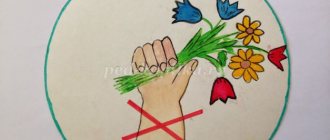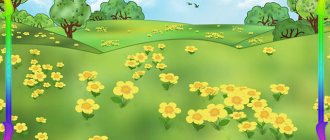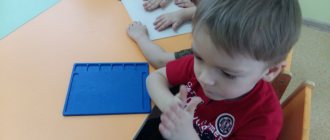Synopsis of an educational lesson in the second junior group. Fish
Summary of an educational and entertaining event for children of the second group of younger age “Amazing Fishes”
Program content: Objectives: • Teach children to correctly pronounce new words and consolidate the pronunciation of already familiar words • Continue to develop fine motor skills using finger games. • Fix the primary colors red, blue, yellow, green. • Develop interest in various types of musical and rhythmic games. • To foster in children an emotional response to joint activities. Materials and equipment: Plastic fish of different colors, a bowl of water, nets of different sizes, imitation of the shape of an aquarium, rectangular and round, blanks for applique, brushes, glue.
Progress of the event
Educator. Hello guys. Look what we have. “A basin filled with water” and a net. Game-exercise “Let's look” Children, optionally using a net, “catch” toys - fish. While fishing, children note the size of the fish and its color. Educator. How many fish did we catch? Do you like them? Educator. Look and tell me what the fish has? Children. Head, eyes, tail. Educator. The fish has a body. Here it is, show me. What is in the front of the body? Children. Head. Educator. Show where the fish's head is. What's on the fish's head? Children. On the head there are eyes and a mouth. Educator. That's right, the fish has its head in the front, and what's in the back? Children. Behind the tail. Educator. Do you have a tail? You don't have a tail, but the fish does. He is behind her. Show. The back of the fish is on top. It has a belly underneath. Show. Now let's show how fish swim. Children put their palms together and make wave-like movements, imitating the movements of fish. Educator. Guys, let's imagine that you and I have also turned into real fish and play. Articulation gymnastics “Fishes” “Bubbles burst”…. Silent pronunciation [n], the tempo of pronunciation is either speeded up or slowed down.
"Predatory fish" ....
Raise the upper lip, exposing only the upper teeth.
“The fish is chewing algae”….
Imitate chewing.
"Pike" ….
Move the lower jaw forward, mouth open, bite the upper lip with the lower teeth.
“The fish is singing”….
Extend your lips into a “tube” and slowly open your mouth, and also slowly close it. Educator. What wonderful fish we have! Guys, tell me, who knows where the fish live? Children's answers. Educator. That's right, guys. Fish can live in the sea, in the ocean, in a river or lake, and even in an aquarium. The most important thing that fish need to live is water! Look, I have two aquariums. (Round and rectangular). Guys, what shape are these aquariums? Educator. I suggest you play the game. D/i “Find your house” The teacher puts silhouettes of rectangular and round aquariums on the floor, then invites them to play. The fish “swim” wherever they want. As soon as I say “I want to catch you,” you run to your houses. Whoever has a big fish runs to a rectangular aquarium, and whoever has a small fish runs to a round aquarium. The fish swims in the water, the fish has fun playing. Fish, fish, mischief maker, I want to catch you. Educator. Well done guys, everyone hid in their houses. And now it’s time for us to turn from fish to children again. I have a surprise for you. I have prepared such wonderful aquariums for each of you. Every aquarium should have a fish, and together we will make a fish. Children, under the guidance of a teacher, perform an application of cotton pads “Fish in an Aquarium”. Educator. You guys made some wonderful fish. Well done





